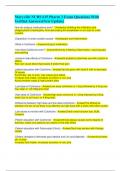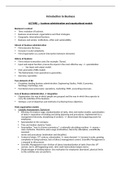Maryville NURS 615 Pharm 3 Exam Questions With
Verified Answers(New Update)
How do antigout medications work? - Answerby inhibiting the infiltration and
phagocytosis of leukocytes, thus decreasing the breakdown of uric acid to urate
crystals.
.Deposition of urate crystals causes - Answerpain and inflammation
.What is Colchicine - Answeranti-gout medication
.how does Colchicine work? - AnswerWorks by inhibiting inflammation, reducing pain
and swelling
.common side effects of Colchicine - AnswerGI problems (diarrhea) use with caution in
elderly
Also can cause blood dyscrasias & abdominal pain
.patient education with Colchicine - AnswerCan be given with food & milk to decrease
GI issues
Avoid beer, ale, & wine: may cause gout attack
Increase fluid intake: increases excretion of uric acid
Avoid smoked meats & high-protein diets
.Low dose of Colchicine - AnswerLow dose colchicine is 1.2mg followed by 0.6mg one
hour later or 1.8 milligrams total
.High dose of Colchicine - Answerhigh dose colchicine is 1.2mg followed by 0.6mg
every four to six hours; or 4.8mg total.
.Difference between high dose and low dose Colchicine - AnswerThe difference
between the two is low dose is as effective as high dose with a lower side effect profile.
.Lab values to monitor with Colchicine - AnswerCheck renal function test, BUN,
Creatine
.Patient education with Colchicine - AnswerAlmost always causes some degree of
diarrhea, make sure patients are aware of this side effect
.Patient education with Febuxostat (Uloric) - AnswerGout may worsen with therapy
initially
.Dietary changes to decrease gout attacks and uric acid deposits. - AnswerAvoid beer,
ale, & wine
Increase fluid intake: increases excretion of uric acid
,Avoid smoked meats & high-protein diets
.WHO 3 step ladder for pain medication - Answer
.What is not a first line for pain medication? - AnswerNarcotics
.Recommendations for pain treatment - AnswerYou want to start with NSAIDs first and
then work your way up from there.
.types of Corticosteroid treatment - AnswerPrednisone, Cortisone, Dexamethasone
.how do Corticosteroids work? - AnswerSuppress the inflammatory & immune systems
by inhibiting the synthesis of chemical mediators.
.what are the chemical mediators that Corticosteroids work on? -
AnswerProstaglandins, leukotrienes, & histamines
.Corticosteroids and inflammation - AnswerDecreases inflammation which decreases
swelling, warmth, redness, & pain.
.Uses for corticosteroid treatment - AnswerAddison's disease, hormone replacement,
cancer therapy
SLE, arthritis, IBD, & to suppress graft rejection
.contraindications for corticosteroid treatment - AnswerSystemic fungal infections & with
live vaccine
.Use corticosteroids cautiously with: - AnswerPregnancy, kids, HTN, heart failure, renal
impairment, & with infections resistant to treatment
.Patient education with corticosteroids - AnswerDon't discontinue abruptly, doses may
need increased during stress, symptoms of Cushing's and GI bleeding
.Problem with taking Corticosteroids for greater than 6 months - AnswerThe main thing
you want to worry about is osteoporosis it can also worsen diabetic control and patients
should report any tarry black stools or abdominal pain.
.Other common side effects with Corticosteroids - AnswerPeptic ulcers, GI bleeding,
edema, hyperglycemia, delayed wound healing, fluid & electrolyte imbalances
.Why is it important to tapper the corticosteroid? - AnswerTapering must be done
carefully to avoid both recurrent activity of the underlying disease process and possible
cortisol deficiency resulting from the hypothalamic-pituitary-adrenal axis or HPA
suppression during the period of steroid therapy
, .Black box warning - AnswerIncreased risk of serious cardiovascular thrombotic events,
myocardial-infarction and stroke which can be fatal.
.What increases risk of black box warning occurring with NSAIDs. - AnswerRisk
increases with duration of use.
Patients with cardiovascular disease or with risk factors for cardiovascular disease may
be a greater risk.
.NSAIDs and GI system - AnswerIncreased risk of serious gastrointestinal adverse
effects including: bleeding, ulceration, and perforation the stomach or intestines can be
fatal.
Can occur at any time during use and without warning symptoms. Elderly patients are at
greater risk for serious GI events.
.Ibuprofen and mechanism of action - AnswerExact mechanism of action is unknown.
A non-selective cox-2 inhibitor in that it inhibits two isoforms of psychologic oxygenase
cox-1 and cox-2.
A non-selective inhibitor of cyclooxygenase, believed to be due to inhibition of cox-2
which decreases the synthesis of prostaglandins in mediating the inflammation pain,
fever, and swelling.
.Ibuprofen and antipyretic effects - AnswerAntipyretic effects may be due to action on
the hypothalamus resulting in an increase of peripheral blood flow, basil dilation, and
subsequent heat dissipation.
.Ibuprofen versus NSAIDs - AnswerThe analgesic and antipyretic and anti-inflammatory
activity of NSAIDs appear to operate mainly through inhibition of cox-2. Resident
inhibition of cox-1 would be responsible for the unwanted effects on the GI tract.
Inhibition of cox-1 is thought to cause some of the side effects of ibuprofen including GI
ulceration like aspirin and indomethacin.
.Ibuprofen versus NSAIDs - Answerlike aspirin and indomethacin.
Ibuprofen is also a reversible inhibitor of the cox pathway. On the other hand, aspirin is
a non-reversible inhibitor of the cox pathway.
.cox enzyme pathway - Cyclooxygenase is: - Answerthe prostaglandin-endoperoxide
synthase (PTGS)
.Cyclooxygenase is the prostaglandin-endoperoxide synthase (PTGS)- what does it do?
- AnswerInhibits the formation & release of prostaglandin.
PTGS converts arachidonic to PGH2 which is converted to other prostaglandins that
mediate pain, inflammation, & fever. PGH2 is also converted to thromboxane-A2 which
stimulates platelet aggregation leading to formation of blood clots.
.What happens when one part of the cox pathway is blocked - AnswerUnderstand that
blocking one part of the cox pathway can lead to a build up of different products





